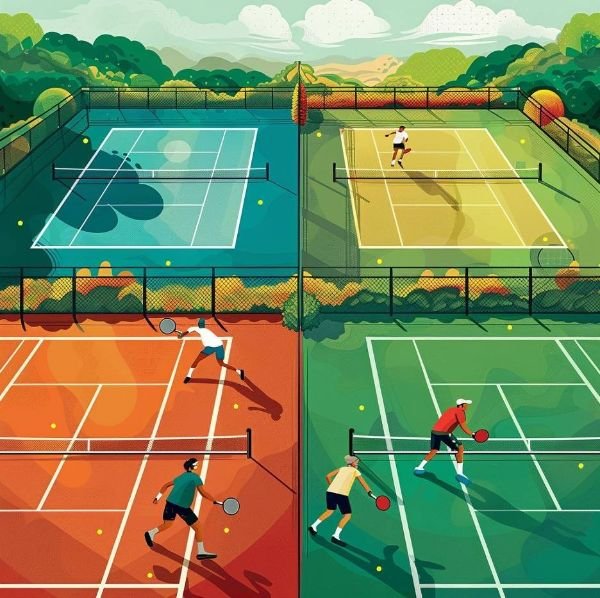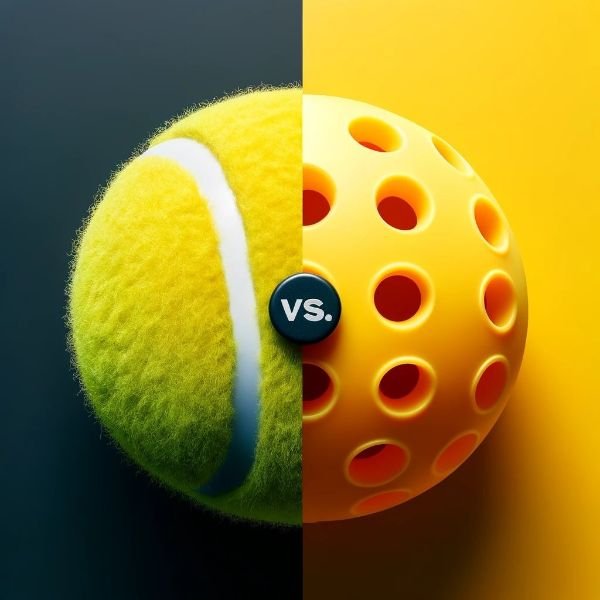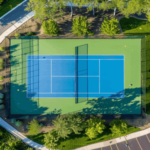Pickleball and tennis are two of the most popular racquet sports among adults in the USA, especially within the 45-55 age group. While both sports involve racquets, a net, and a court, they have distinct differences that can significantly impact a player’s choice. Furthermore, pickleball vs tennis is a trending topic for many sports enthusiasts. By understanding these distinctions, you can better decide which sport best suits your lifestyle and preferences.
Table Of Content
Pickleball vs Tennis: Key Differences
Here’s a detailed comparison:
- Court Size: A pickleball court is significantly smaller than a tennis court, measuring only 20 x 44 feet, about a third of the tennis court size. This makes pickleball more accessible and less physically demanding, particularly for those looking to avoid extensive running.
- Equipment: Pickleball equipment is lighter than tennis gear. The paddles used in pickleball are larger than table tennis paddles but smaller and lighter than tennis rackets. This makes the game easier to learn and play, especially for beginners.
- Ball: The pickleball is smaller than a tennis ball, made of hard plastic with holes (similar to a wiffle ball), which makes it less bouncy and slower in flight compared to the felt-covered tennis balls.
- Net Height: The net in pickleball is two inches lower than in tennis, standing at 34 inches in the center. This adjustment encourages more volleys and faster-paced action close to the net.
- Scoring: Pickleball uses a unique scoring system where you can only score points on your serve, with games typically played to 11 points, winning by 2. Tennis, however, employs a more complex scoring structure with games, sets, and matches to decide the winner.
- Serving: In pickleball, the serve must be underhand, adding a different strategic layer. Tennis allows powerful overhand serves that can dominate the game flow.

How the Game is Played: Rules and Scoring
Understanding the rules and scoring can give you insight into the strategic differences between pickleball and tennis.
Pickleball Rules and Scoring
- Serve Rules: Players must serve underhand and diagonally across the court, with the serve needing to clear the non-volley zone, often called the kitchen.
- Scoring: Games are typically played to 11, 15, or 21 points, with players needing to win by 2 points. Only the serving side can score.
- The Kitchen: A key rule in pickleball is the non-volley zone (the kitchen), where players cannot volley the ball. This rule prevents smash volleys from close to the net, promoting longer rallies.
Tennis Rules and Scoring
- Serve Rules: Players can serve overhand, and the serve must go diagonally into the opposite service box. Faults and double faults play a significant role in the game dynamics.
- Scoring: Tennis uses a sequence of points (15, 30, 40, and game), with six games needed to win a set. Matches are often best of three or five sets.
- Tie-Breaks: At a 6-6 game score, tennis often employs a tie-break to decide the set, adding drama and intensity to the matches.
| Aspect | Pickleball | Tennis |
|---|---|---|
| Serve Rules | Players must serve underhand and diagonally across the court, with the serve needing to clear the non-volley zone (the kitchen). | Players can serve overhand, and the serve must go diagonally into the opposite service box. Faults and double faults play a significant role in the game dynamics. |
| Scoring | Games are typically played to 11, 15, or 21 points, with players needing to win by 2 points. Only the serving side can score. | Tennis uses a sequence of points (15, 30, 40, and game), with six games needed to win a set. Matches are often best of three or five sets. |
| Special Rules | A key rule in pickleball is the non-volley zone (the kitchen), where players cannot volley the ball. This rule prevents smash volleys from close to the net, promoting longer rallies. | At a 6-6 game score, tennis often employs a tie-break to decide the set, adding drama and intensity to the matches. |
Equipment and Gear: What You Need to Know
The lightweight pickleball paddle and plastic ball, key components that differ from tennis.
Pickleball Equipment
- Paddles: Made from lightweight composite materials like graphite or carbon fiber, offering ease of movement and control.
- Balls: Plastic balls with holes, designed to fly slower and with less bounce, accommodating indoor and outdoor play.
Tennis Equipment
- Rackets: Larger and made from a mix of materials including graphite for strength and power. Tennis rackets are designed to provide a balance of control, power, and spin.
- Balls: Pressurized felt-covered rubber balls that are designed for speed and bounce, varying for different court surfaces.
| Aspect | Pickleball | Tennis |
|---|---|---|
| Racket | Smaller paddles, typically made of lightweight composite materials such as graphite or fiberglass. | Larger racquets, made of materials like graphite, carbon fiber, or composite alloys, with strings for striking the ball. |
| Ball | Lightweight plastic wiffle balls with holes, designed to reduce speed and bounce. | Pressurized rubber balls with a felt covering, designed for high bounce and speed. |
Health Benefits and Physical Demands
Both sports offer excellent health benefits, but their physical demands vary significantly, which can influence preference.
Health Benefits
- Pickleball: Offers cardiovascular fitness, improves reflexes, and enhances muscle strength, all with lower impact on joints. It’s excellent for improving balance and agility with less risk of injury.
- Tennis: Provides a vigorous cardiovascular workout, improves hand-eye coordination, strengthens muscles, and enhances flexibility. The sport’s higher impact can strengthen bones but also lead to more strain on joints.
Physical Demands
- Pickleball: Less running and lower impact due to the smaller court. The gameplay encourages more strategic, placement-focused rallies rather than power-based play.
- Tennis: More intense running and higher impact. The larger court and faster ball speed require greater physical agility and endurance.
| spect | Pickleball | Tennis |
|---|---|---|
| Health Benefits | Improves cardiovascular health, enhances hand-eye coordination, promotes social interaction, and is accessible to all fitness levels. | Enhances cardiovascular health, improves agility and coordination, strengthens muscles, and burns more calories due to higher intensity. |
| Physical Demands | Less intense, with shorter court distances and fewer high-impact movements, making it suitable for older adults or those with joint issues. | More intense, requiring significant running, lateral movements, and stamina, making it more demanding on the body. |
Community and Social Aspects
The community and social interactions in pickleball and tennis can significantly affect a player’s experience.
Pickleball Community: Known for its welcoming and inclusive nature, pickleball clubs and community centers often host social mixers, clinics, and beginner-friendly events. These activities help new players integrate and improve, making it easy for anyone to join and feel included.
Tennis Community: While tennis is also social, it can be more competitive, with a focus on leagues, rankings, and more formalized club play. Nevertheless, many tennis communities also offer social play opportunities and mixers, providing a balance between competition and socializing.
Social Play: Additionally, pickleball courts often see players rotating in and out more frequently, which can lead to a higher volume of social interaction. In contrast, tennis may offer more in-depth play with the same partner or group due to the longer match format, allowing for stronger bonds to form over time.
Why Players Are Switching from Tennis to Pickleball
Pickleball’s surge in popularity is partly due to many tennis players switching to the sport. Here are some compelling reasons behind this trend:
- Social Aspect: Firstly, pickleball is perceived as more social and less competitive than tennis. The smaller court size fosters closer interaction and communication among players, which enhances the social experience during the game.
- Ease of Learning: Secondly, the rules and equipment in pickleball are simpler and more intuitive, allowing new players to quickly learn the game and enjoy it without a steep learning curve.
- Physical Demand: Additionally, pickleball is less physically demanding due to the smaller court and lighter equipment. This aspect is particularly appealing to those seeking a sport that is easier on the joints and muscles but still provides good physical activity.
- Growing Community: Furthermore, the pickleball community is rapidly expanding, with more courts being built and tournaments being organized. This growth makes it easy for players to find places to play and new people to meet and compete with.
- Accessibility: Lastly, due to the smaller court size and simpler scoring system, pickleball is more accessible to a wider range of ages and skill levels.

Conclusion
Pickleball vs tennis is more than just a comparison of two sports; it’s about choosing a game that aligns with your physical capabilities, social preferences, and enjoyment. Whether you prefer the engaging, friendly game of pickleball or the traditional, strategic challenge of tennis, both sports offer fantastic opportunities for exercise, socializing, and competitive play. Additionally, both games provide unique health benefits and cater to different physical demands, making them suitable for various age groups and fitness levels. Ultimately, the choice between pickleball and tennis depends on your personal preferences and what you seek in a sport.


